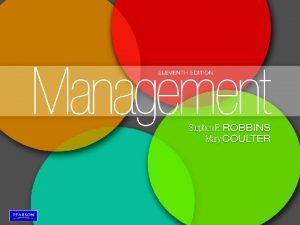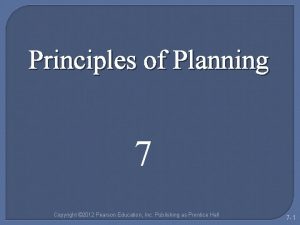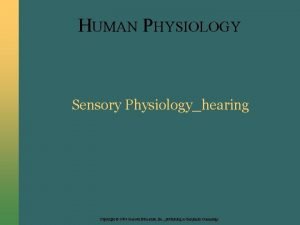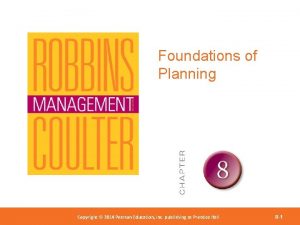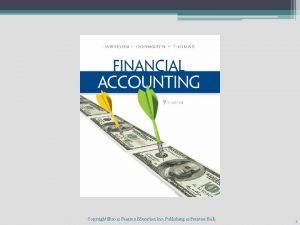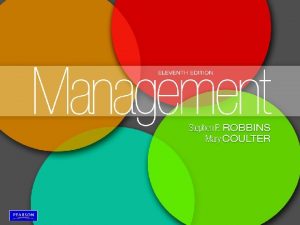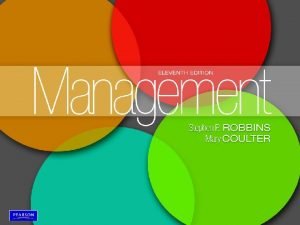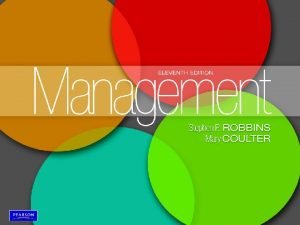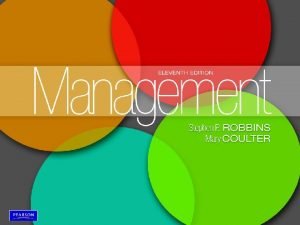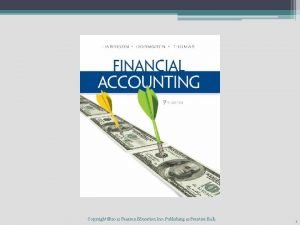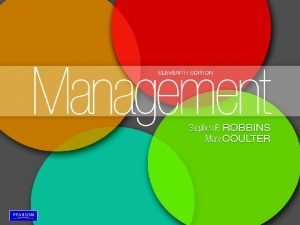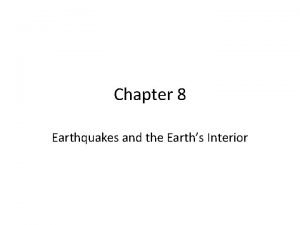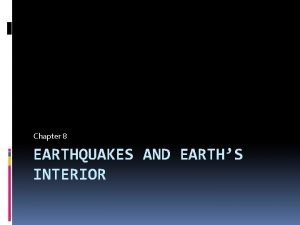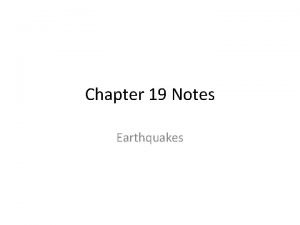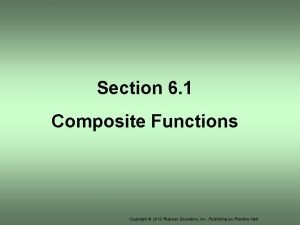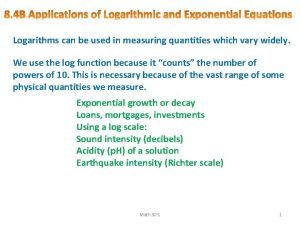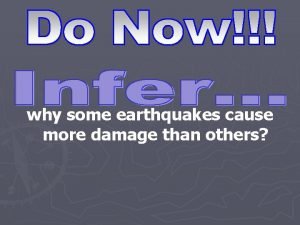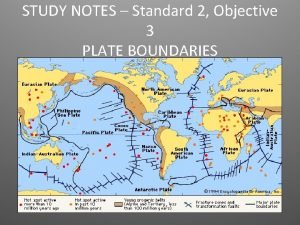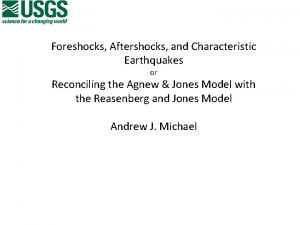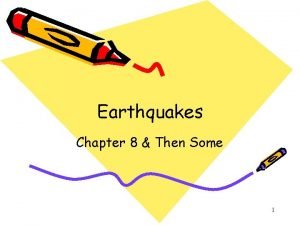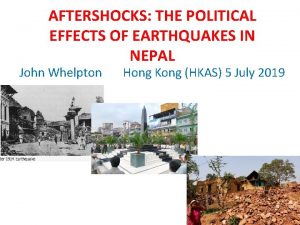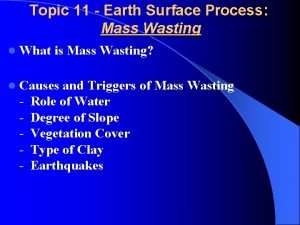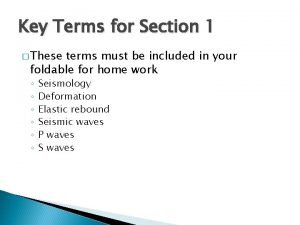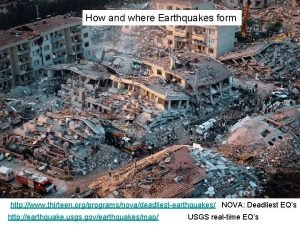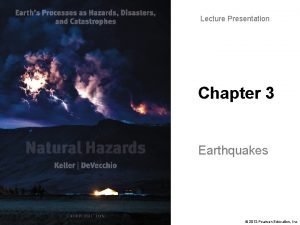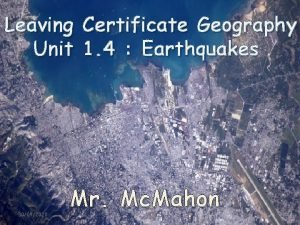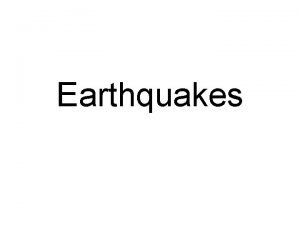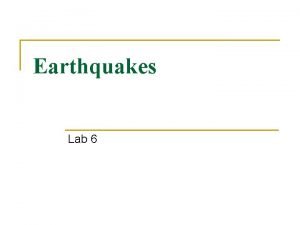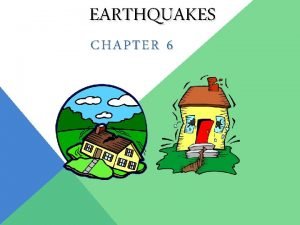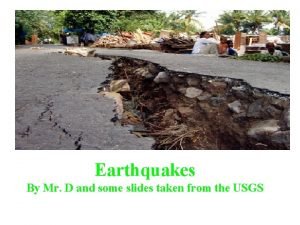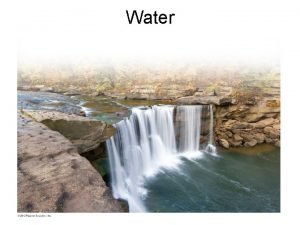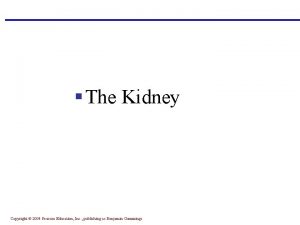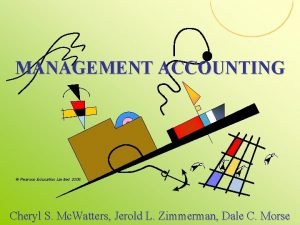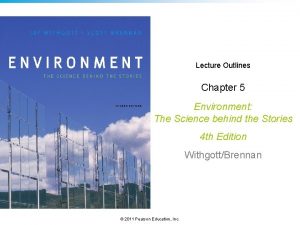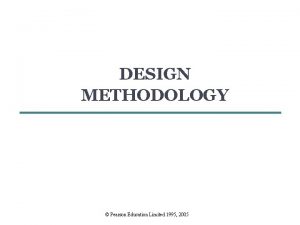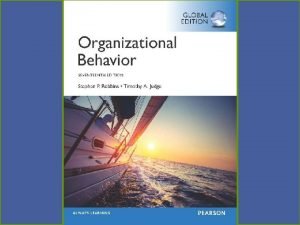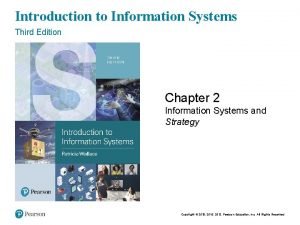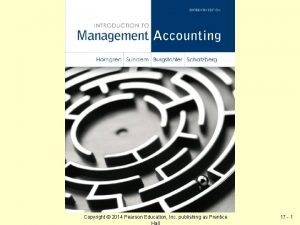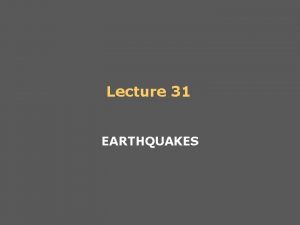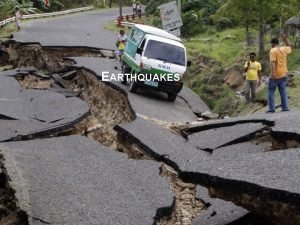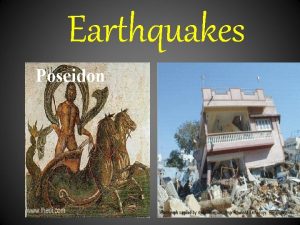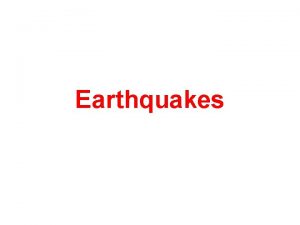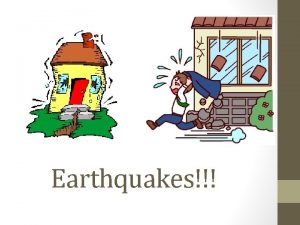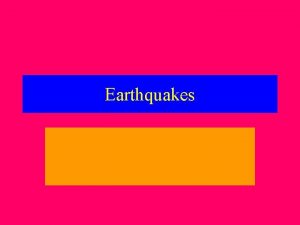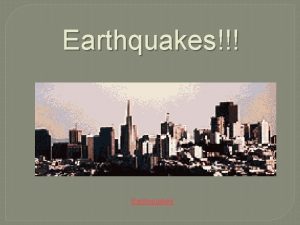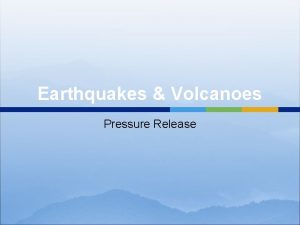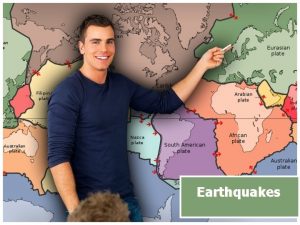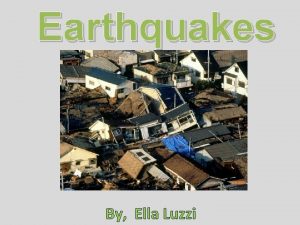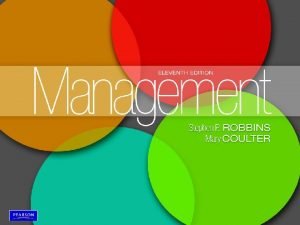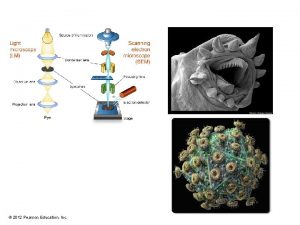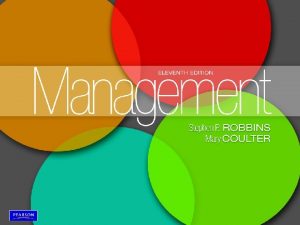Lecture Presentation Chapter 3 Earthquakes 2012 Pearson Education







































































- Slides: 71

Lecture Presentation Chapter 3 Earthquakes © 2012 Pearson Education, Inc.

Introduction to Earthquakes § There are many earthquakes in any given day § They are compared based on: § Magnitude, the amount of energy released § Intensity, the effects on people and structures © 2012 Pearson Education, Inc.

Table 3. 1 © 2012 Pearson Education, Inc.

Earthquake Magnitude § They are mapped according to epicenter § Focus is directly below the epicenter § Measured by moment magnitude § Determined from area of rupture along, amount of slippage, and the rigidity of the rocks § Richter scale was previously used Figure 3. 2 © 2012 Pearson Education, Inc.

Earthquake Magnitude, cont. § Both scales are logarithmic § Based on powers of 10 § Ground displacement for a magnitude 3 earthquake is 10 times that for a magnitude 2 § Ground motion is measured by seismograph § Related to magnitude, depth, and geologic setting Table 3. 2 © 2012 Pearson Education, Inc.

Seismograph and inertia Notice that it is the mass that is moving, not the drum. A heavy mass is used (more inertia) and is suspended so that it is less effected by whatever it is attached to. See the animation next. © 2012 Pearson Education, Inc.

Earthquake Intensity § Measured by Modified Mercalli Scale § Qualitative scale (I-XII) based on damage to structures and people’s perceptions § Modified Mercalli Intensity Maps show where the damage is most severe © 2012 Pearson Education, Inc.

Table 3. 4 © 2012 Pearson Education, Inc.

Shake Maps § Shake Maps use seismograph data to show areas of intense shaking Figure 3. 3 © 2012 Pearson Education, Inc.

Figure 3. 20 © 2012 Pearson Education, Inc.

© 2012 Pearson Education, Inc.

Earthquake Processes § Earthquakes are distributed along faults § Places where rocks are broken and displaced § All plate boundaries are faults § Movement along faults are slip rates § Measured in mm/yr or m/1000 yr § Sudden rupture of rock produces seismic waves § Release of stored energy © 2012 Pearson Education, Inc.

Figure 3. 5 © 2012 Pearson Education, Inc.

Focus and Epicenter Focus – where the earthquake happens Epicenter – the spot on the surface above the focus © 2012 Pearson Education, Inc.

© 2012 Pearson Education, Inc.

Elastic Rebound Stress causes the ground begins to be deformed. An earthquake occurs when a rock passes its point of maximum elasticity. After it breaks, it regains its original shape (but not position. ) © 2012 Pearson Education, Inc.

Fault Types—Strike-Slip § Crust moves in horizontal direction Figure 3. 6 a © 2012 Pearson Education, Inc.

Fault Types—Dip-Slip § Vertical movement § Include two walls defined by miners as: § Footwall § Hanging wall © 2012 Pearson Education, Inc.

Fault Types—Dip-Slip, cont. § Normal fault § Hanging wall moves down relative to footwall § Reverse fault § Hanging wall moves up relative to footwall § If angle is 45° or less it is a thrust fault § Blind faults do not extend to the surface © 2012 Pearson Education, Inc.

Figure 3. 6 b Figure 3. 6 c © 2012 Pearson Education, Inc.

Figure 3. 7 © 2012 Pearson Education, Inc.

Fault Activity § Active fault § Moved during the past 10, 000 years of the Holocene Epoch § Potentially active faults § Moved during the Pleistocene, but not the Holocene Epoch § Inactive § Not moved during the past 2 million years § Paleoseismicity of the fault © 2012 Pearson Education, Inc.

Seismic Waves—Body Waves § Caused by a release of energy from rupture of a fault § Travel through the body of the Earth § P waves, primary or compressional waves § Move fast with a push/pull motion § Can move through solid, liquid and gas § It is possible to hear them § S waves, secondary or shear waves § Move slower with an up/down motion § Can travel only through solids © 2012 Pearson Education, Inc.

Figure 3. 9 a, b © 2012 Pearson Education, Inc.

Seismic Waves P(Primary) – body wave S(Secondary) – body wave L(Long) – surface wave © 2012 Pearson Education, Inc.

The shadow zone § Notice in this diagram that S waves are absorbed by the liquid outer core. P waves are refracted by the outer core, because waves refract (bend) when they enter a new medium at an angle. This is how geologists found out that the outer core is liquid. © 2012 Pearson Education, Inc.

Seismic Waves—Surface Waves § Move along Earth’s surface § Travel more slowly than body waves § Move both vertically and horizontally with a rolling motion § Are responsible for most of the damage near epicenter § Love wave—horizontal ground shaking © 2012 Pearson Education, Inc.

Figure 3. 9 c © 2012 Pearson Education, Inc.

Videos § http: //video. nationalgeographic. com/video/enviro nment/environment-naturaldisasters/earthquake-101/ § http: //video. nationalgeographic. com/video/enviro nment/environment-naturaldisasters/earthquake-montage/ § http: //video. nationalgeographic. com/video/enviro nment/environment-naturaldisasters/earthquakes/inside-earthquake/ © 2012 Pearson Education, Inc.

Earthquake Shaking § Shaking experience depends on: § Earthquake magnitude § Location in relation to epicenter and direction of rupture § Local soil and rock conditions © 2012 Pearson Education, Inc.

Distance to Epicenter § Both types of body waves are emitted from epicenter of quake § Seismographs record arrivals of waves to station site § Seismogram is the record of the waves § P and S waves travel at different rates and arrive at station at different times § Distance to epicenter can be found by comparing travel times of the waves © 2012 Pearson Education, Inc.

Figure 3. 10 c © 2012 Pearson Education, Inc.

Seismogram- recording from seismograph P wave arrives first S wave then arrives The time between them tells you how far away they came from. Notice that it is 5 minutes from P to S wave. The graph on the next page shows how to do this 5 minutes © 2012 Pearson Education, Inc.

Distance Graph Another graph allows you to find the distance to the epicenter using a line that shows the difference in arrival time between P and S waves. The one shown can only be used for distances from 300 – 750 km. Simply read the distance off the line, as shown. Let us see how far an epicenter is if the difference between P and S waves is 60 seconds. About 580 km. © 2012 Pearson Education, Inc.

Finding the Epicenter Three seismograph stations are needed. Why? Each location gives us a distance, so we can draw a circle there. Then the intersection of 3 circles gives us the epicenter. © 2012 Pearson Education, Inc.

Finding Magnitude Use the distance you calculated from the seismogram and graph. Then find the amplitude of the S-wave on the seismogram. Put these two quantities on the opposite sides of this special graph called a nomogram. Connect them with a line, and this gives you the magnitude. © 2012 Pearson Education, Inc.

Let’s try one here. Use the time difference of 35 seconds to find the distance to the epicenter. The difference in arrival times between the P and S wave here is about 35 sec. (These graphs are all in seconds. ) The amplitude of the S wave is about 350 mm. About 340 km © 2012 Pearson Education, Inc.

Finding the Magnitude Now mark the distance and amplitude on the graph here - called a nomogram. (Watch the graph carefully as we click here) And then connect them with a line. Where the line intersects the magnitude line, you have found the magnitude. This one is about 6. 7, right? We will do some for practice here. © 2012 Pearson Education, Inc.

Location of Epicenter § At least three stations are needed to find exact epicenter § Distances from epicenter to each station are used to draw circles representing possible locations § The place where all three circles intersect is the epicenter § Process is called triangulation © 2012 Pearson Education, Inc.

Figure 3. 12 © 2012 Pearson Education, Inc.

Local Geologic Conditions § Nature of the ground materials affects the earthquake energy § Different materials respond differently to an earthquake § Depends on their degree of consolidation § Seismic wave move faster through consolidated bedrock § Move slower through unconsolidated sediment § Move slowest through unconsolidated materials with high water content § Material amplification § Energy is transferred to the vertical motion of the surface waves © 2012 Pearson Education, Inc.

Figure 3. 14 © 2012 Pearson Education, Inc.

The Earthquake Cycle § There is a drop in elastic strain after an earthquake and a reaccumulation of strain before the next event § Strain is a deformation § Elastic strain is deformation that is not permanent § Stage 1: Period of inactivity along a segment of fault § Stage 2: Period of small earthquakes where the stress begins to release causing strain § Stage 3: Foreshocks occur prior to a major release of stress § Doesn’t always occur © 2012 Pearson Education, Inc.

The Earthquake Cycle, cont. § Stage 4: Mainshock and aftershocks where the fault releases all pent up stress releases the major quake § Cycle is hypothetical and periods are variable § Stages have been identified for many large earthquakes © 2012 Pearson Education, Inc.

Figure 3. 19 © 2012 Pearson Education, Inc.

Plate Boundary Earthquakes § Subduction Zones § Site of the largest earthquakes § Megathrust earthquakes § Example: Cascade Mountains § Convergence between a continental and oceanic plate § Example: Aleutian Islands § Convergence between two oceanic plates § Transform Fault Boundaries § Example: San Andreas Fault in California, Loma Prieta earthquake § Boundary between North American and Pacific plates © 2012 Pearson Education, Inc.

Intraplate Earthquakes § Earthquakes that occur within plates § New Madrid seismic zone § Located near St. Louis, MO § Historic earthquakes similar in magnitude to West Coast quakes § Earthquakes are often smaller than plate boundary quakes § Can be large and cause considerable damage due to lack of preparedness and because they can travel greater distances through stronger continental rocks © 2012 Pearson Education, Inc.

Effects of Earthquakes § Ground rupture § Displacement along the fault causes cracks in surface § Fault scarp § Shaking § Causes damage to buildings, bridges, dams, tunnels, pipelines, etc. § Measured as Ground Acceleration § Buildings may be damaged due to resonance § Matching of vibrational frequencies between ground and building © 2012 Pearson Education, Inc.

Effects of Earthquakes, cont. 1 § Liquefaction § A near-surface layer of water-saturated sand changes rapidly from a solid to a liquid § Causes buildings to “float” in earth § Common in M 5. 5 earthquakes in younger sediments § After shaking stops, ground re-compacts and becomes solid § Elevation changes § Regional uplift and subsidence § Can cause substantial damage on coasts and along streams © 2012 Pearson Education, Inc.

Effects of Earthquakes, cont. 2 § Landslides § Earthquakes are the most common triggers in mountainous areas § Can cause a great loss of human life § Can also block rivers creating “earthquake lakes” § Fires § Displacements cause power and gas lines to break and ignite § Hard to put out because water lines are often broken § Disease § caused by a loss of sanitation and housing, contaminated water supplies, disruption of public health services, and the disturbance of the natural environment © 2012 Pearson Education, Inc.

Effects of Earthquakes § Shaking and Ground Rupture § Liquefaction http: //www. youtube. com/watch? v=I 3 h. JK 1 Bo. Rak § Change in land elevation § Landslides § Fires § Disease © 2012 Pearson Education, Inc.

Natural Service Functions § Water, oil, and natural gas may be rerouted due to faults § New mineral resources may be exposed § Scenic landscapes may form § Future earthquakes may be reduced due to release of energy © 2012 Pearson Education, Inc.

Human Interaction with Earthquakes § Loading Earth’s crust, as in building a dam and reservoir • The weight from water reservoirs may create new faults or lubricate old ones § Injecting liquid waste deep into the ground through disposal wells • Liquid waste disposals deep in the earth can create pressure on faults § Creating underground nuclear explosions • Nuclear explosions can cause the release of stress along existing faults © 2012 Pearson Education, Inc.

Minimizing the Earthquake Hazard § Focus of minimization is on forecasting and warning § National Earthquake Hazard Reduction Program Goals § § Develop an understanding of the earthquake source Determine earthquake potential Predict effects of earthquakes Apply research results © 2012 Pearson Education, Inc.

Estimating Seismic Risk § Hazard maps show earthquake risk § Probability of a particular event or the amount of shaking Figure 3. 29 © 2012 Pearson Education, Inc.

Short-Term Prediction § Pattern and frequency of earthquakes § Foreshocks § Deformation of ground surface § Changes in land elevation § Seismic gaps along faults § Areas that have not seen recent quakes § Geophysical and Geochemical changes § Changes in Earth’s magnetic field, groundwater levels. © 2012 Pearson Education, Inc.

Community Preparations for Earthquake Hazard § Critical facilities must be located in earthquake safe locations § Requires detailed maps of ground response § Buildings must be designed to withstand vibrations § Retrofitting old buildings may be necessary § People must be prepared through education § Insurance must be made available © 2012 Pearson Education, Inc.

Personal Reactions and Preparation § Do a home inspection to make sure that your home is structurally sound § Secure large objects § Make a personal plan of how to react to a quake § Leave buildings AFTER shaking stops § Turn off main gas line § Move to an open area © 2012 Pearson Education, Inc.

Introduction § Tsunamis: The Japanese word for “large harbor waves”, produced by the sudden vertical displacement of ocean water § Can be triggered by any rapid uplift or subsidence of the seafloor, such as submarine earthquake, landslide, volcanism, and impact of asteroid or comet § Mega-tsunami, from asteroid impact, a wave about 100 times higher than the largest tsunami produced by an earthquake § Tsunamis produced by earthquakes are by far the most common © 2012 Pearson Education, Inc.

Figure 7. 3 © 2012 Pearson Education, Inc.

How Do Earthquakes Cause a Tsunami? § Cause a tsunami by movement of the seafloor and by triggering a vertical displacement/ landslide § M 7. 5 or greater earthquake create enough displacement of the seafloor to generate a damaging tsunami § A four-stage process that eventually leads to landfall of tsunami waves on the shore Figure 7. 7 © 2012 Pearson Education, Inc.

Figure 7. 7 © 2012 Pearson Education, Inc.

Tsunami Movement § When an earthquake uplifts the seafloor close to land, both distant and local tsunamis may be produced § Distant tsunami: Travels out across the deep ocean at high speed for thousands of kilometers to strike remote shorelines with very little loss of energy § Local tsunami: Heads in the opposite direction toward the nearby land arrives quickly following an earthquake § When the initial tsunami wave is split, each (distant and local) tsunami has a wave height about one-half of that of the original dome of water © 2012 Pearson Education, Inc.

Distant and Local Tsunami Figure 7. 8 © 2012 Pearson Education, Inc.

Landslides Cause a Tsunami § Submarine landslides can generate very large tsunamis § Large rock avalanches falling from mountains into the sea can also generate very large tsunamis § 1998, a M 7. 1 earthquake triggered a submarine landslide and caused a tsunami of 15 m (50 ft), leaving 12, 000 people homeless and over 2, 000 dead § Lituya Bay, Alaska, in 1958. The landslide set in motion by a M 7. 7 earthquake on a nearby fault. The huge mass of broken rock caused waters in the bay to surge upward to an elevation of about 524 m (1720 ft) above the normal water level © 2012 Pearson Education, Inc.

Regions at Risk § All ocean and some lake shorelines are a risk for tsunamis, some coasts are more at risk than others § Coasts close to a major subduction zone or directly across the ocean basin from a major subduction zone are at greatest risk § The greatest tsunami hazard with return periods of several hundred years § High risk regions: The Cascadia subduction zone, the Chilean trench, the subduction zones off the coast of Japan, parts of the Mediterranean, as well as the northeastern side of the Indian Ocean © 2012 Pearson Education, Inc.

Global Tsunami Hazard Ranks Figure 7. 11 © 2012 Pearson Education, Inc.

Effects of Tsunamis Primary § Damage to both the landscape and human structures from resulting flooding and erosion Secondary § Fires may start in urban areas from ruptured natural gas lines or from the ignition of flammable chemicals § Water supplies may become polluted § Damaged wastewater treatment systems § Disease outbreaks © 2012 Pearson Education, Inc.

Minimizing the Tsunami Hazard § § § Detection and warning Structural control Construction of tsunami runup maps Land use planning Probability analysis Education © 2012 Pearson Education, Inc.

Tsunami Warning System Figure 7. 14 © 2012 Pearson Education, Inc.

Detection and Warning § For distant tsunamis: Can be detected in the open ocean and accurately estimated their arrival time to within a few minutes § A tsunami warning system has three components: § A network of seismographs to measure submarine movements § Automated tidal gauges to measure unusual rises and falls of sea level § A network of sensors connected to floating buoys © 2012 Pearson Education, Inc.
 2012 pearson education inc
2012 pearson education inc 2012 pearson education inc
2012 pearson education inc 2012 pearson education inc
2012 pearson education inc 2012 pearson education inc
2012 pearson education inc Olecranal region
Olecranal region 2012 pearson education inc
2012 pearson education inc Pearson education inc. 2012
Pearson education inc. 2012 2012 pearson education inc anatomy and physiology
2012 pearson education inc anatomy and physiology Pearson mbo
Pearson mbo 2012 pearson education inc
2012 pearson education inc Pearson education 2012
Pearson education 2012 2012 pearson education inc
2012 pearson education inc Pearson education 2012
Pearson education 2012 Pearson education inc. 2012
Pearson education inc. 2012 2012 pearson education inc
2012 pearson education inc 2012 pearson education inc
2012 pearson education inc Pearson education 2012
Pearson education 2012 2012 pearson education inc
2012 pearson education inc Pearson education inc all rights reserved
Pearson education inc all rights reserved Pearson education, inc. publishing as prentice hall
Pearson education, inc. publishing as prentice hall Pearson education inc publishing as pearson prentice hall
Pearson education inc publishing as pearson prentice hall Pearson education inc publishing as pearson prentice hall
Pearson education inc publishing as pearson prentice hall Copyright 2008
Copyright 2008 Chapter 8 section 1 what are earthquakes
Chapter 8 section 1 what are earthquakes Chapter 8 earthquakes and volcanoes
Chapter 8 earthquakes and volcanoes Chapter 8 earthquakes and earth's interior
Chapter 8 earthquakes and earth's interior Chapter 19 earthquakes
Chapter 19 earthquakes Chapter 8 earthquakes and earth's interior
Chapter 8 earthquakes and earth's interior Chapter 19 earthquakes
Chapter 19 earthquakes 01:640:244 lecture notes - lecture 15: plat, idah, farad
01:640:244 lecture notes - lecture 15: plat, idah, farad Pearson 2012
Pearson 2012 Educational pearson pearson times
Educational pearson pearson times Stress management for life 5th edition
Stress management for life 5th edition In what section of earth do earthquakes happen
In what section of earth do earthquakes happen Btn earthquakes
Btn earthquakes Natural calamities definition
Natural calamities definition Http://earthquake.usgs.gov/earthquakes/map/
Http://earthquake.usgs.gov/earthquakes/map/ A large crack in the earth formed by a river or earthquakes
A large crack in the earth formed by a river or earthquakes Why some earthquakes cause more damage than others
Why some earthquakes cause more damage than others Frequent earthquakes in an area may indicate *
Frequent earthquakes in an area may indicate * Earthquakes
Earthquakes Quiz 1: earthquakes
Quiz 1: earthquakes Earthquakes
Earthquakes Mass wasting processes
Mass wasting processes Elastic rebound theory
Elastic rebound theory Why do earthquakes occur
Why do earthquakes occur Epicenter of earthquake
Epicenter of earthquake Pearson
Pearson The richer scale
The richer scale Seismograph
Seismograph Crust definition
Crust definition 10 causes of earthquakes
10 causes of earthquakes Whats the main cause of earthquakes
Whats the main cause of earthquakes Types of fault
Types of fault Lecture presentation software
Lecture presentation software Water cycle pearson education
Water cycle pearson education Pearson education, inc
Pearson education, inc Pearson education limited 2008
Pearson education limited 2008 Carbon cycle pearson education
Carbon cycle pearson education Pearson education limited 2005
Pearson education limited 2005 2018 pearson education inc
2018 pearson education inc Pearson education limited 2017
Pearson education limited 2017 Copyright pearson education inc
Copyright pearson education inc 2017 pearson education inc
2017 pearson education inc 2017 pearson education inc
2017 pearson education inc 2017 pearson education inc
2017 pearson education inc 2017 pearson education inc
2017 pearson education inc 2017 pearson education inc
2017 pearson education inc Pearson education inc 4
Pearson education inc 4 Pearson education, inc.
Pearson education, inc. 2014 pearson education inc
2014 pearson education inc 2013 pearson education inc
2013 pearson education inc



